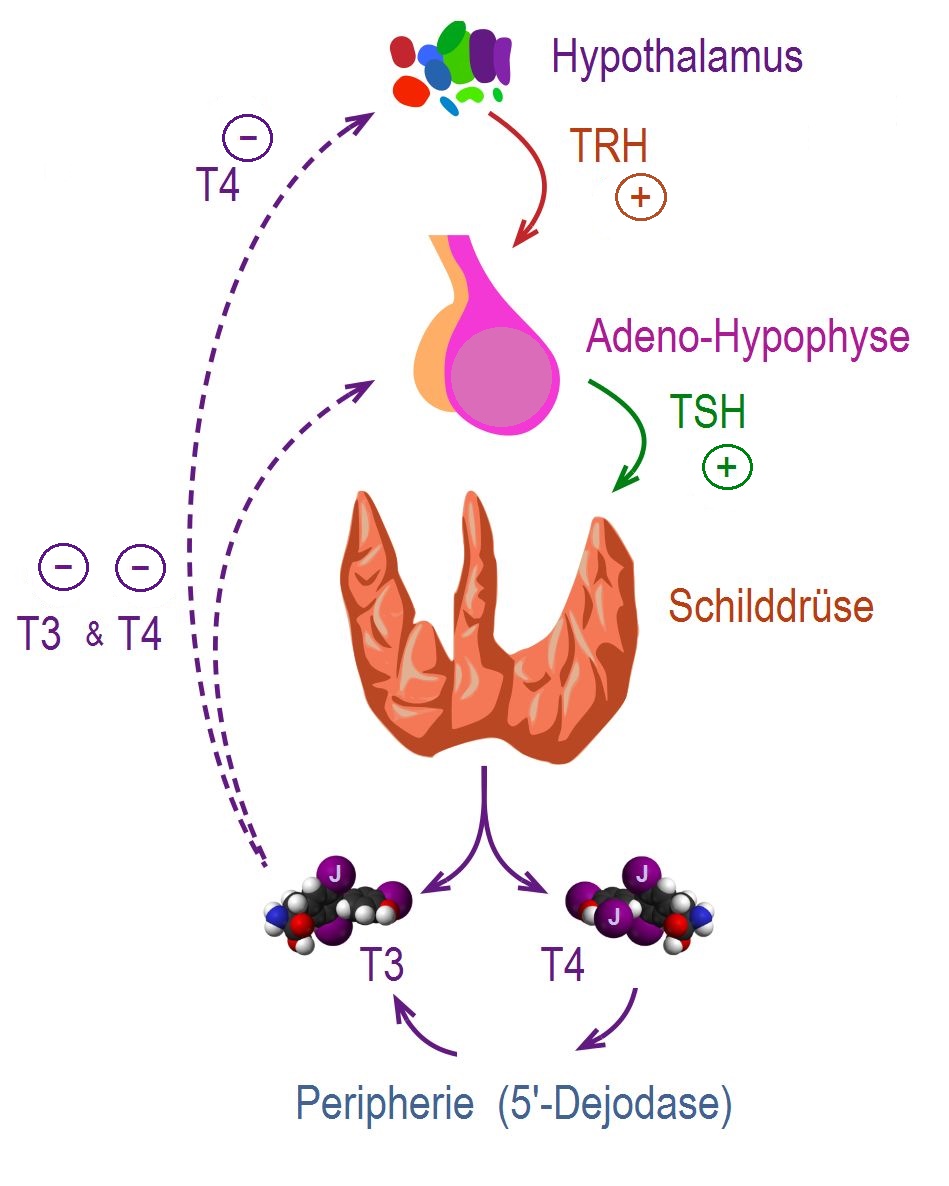Silent thyroiditis pathophysiology
|
Silent thyroiditis Microchapters |
|
Diagnosis |
|---|
|
Treatment |
|
Case Studies |
|
Silent thyroiditis pathophysiology On the Web |
|
American Roentgen Ray Society Images of Silent thyroiditis pathophysiology |
|
Risk calculators and risk factors for Silent thyroiditis pathophysiology |
Editor-In-Chief: C. Michael Gibson, M.S., M.D. [1]; Associate Editor(s)-in-Chief: Furqan M M. M.B.B.S[2]
Overview
The exact pathogenesis of silent thyroiditis is not fully understood. It is thought that silent thyroiditis is the result of an autoimmune phenomenon. Activated matured T-cells (HLA-DR+CD3+), activated helper/inducer T-cells (HLA-DR+CD4+), activated suppressor, and cytotoxic T-cells (HLA-DR+CD8+) were higher in patients with silent thyroiditis as compared to the healthy controls. It indicates that the activation of T cells, especially helper/inducer T cells, might have an important role in the pathogenesis of silent thyroiditis. Silent thyroiditis is associated with the HLA-DR3 and DR5 genes. Lymphocytic infiltration of the thyroid gland, the absence of Hurthle cells and germinal centers on histological analysis are the microscopic histopathological findings suggestive of silent thyroiditis.
Pathophysiology
The control, synthesis, and release of the thyroid hormone is usually controlled by hypothalamus and pituitary gland.[1][2]
|
 |
Pathogenesis
- The exact pathogenesis of silent thyroiditis is not fully understood. It is thought that silent thyroiditis is the result of an autoimmune phenomenon. The following features are suggestive of an autoimmune pathogenesis of silent thyroiditis:[3][4][5][6]
- Lymphocytic infiltration of the thyroid gland
- Presence of antithyroid antibodies
- Association with HLA-DR3 and DR5
- Presence of anti-DNA antibodies
- Activated matured T-cells (HLA-DR+CD3+), activated helper/inducer T-cells (HLA-DR+CD4+), activated suppressor, and cytotoxic T-cells (HLA-DR+CD8+) were higher in patients with silent thyroiditis as compared to the healthy controls. It indicates that the activation of T-cells, especially of helper/inducer T cells, might have an important role in the pathogenesis of silent thyroiditis.[7]
Genetics
Silent thyroiditis is associated with the following HLA genes:[5]
Associated Conditions
The following conditions are associated with silent thyroiditis:[8][9][10][11]
- SLE
- Lymphocytic hypophysitis
- Immune thrombocytopenic purpura (ITP)
- Cushing's syndrome (post adrenalectomy and steroid therapy cessation)
- Hodgkin's lymphoma (post-irradiation)
Gross Pathology
Gross pathology findings in silent thyroiditis include:[12]
- Diffuse goiter
- Slightly enlarged thyroid gland
Microscopic Pathology
- Microscopic histopathological findings in silent thyroiditis include:[3][13]
- Diffuse lymphocytic infiltrate
- Lack of Hurthle cells (Askanazy cells) and germinal centers
- Lack of fibrosis
References
- ↑ De Groot LJ, Chrousos G, Dungan K, Feingold KR, Grossman A, Hershman JM, Koch C, Korbonits M, McLachlan R, New M, Purnell J, Rebar R, Singer F, Vinik A, Rousset B, Dupuy C, Miot F, Dumont J. "Thyroid Hormone Synthesis And Secretion". PMID 25905405.
- ↑ Kirsten D (2000). "The thyroid gland: physiology and pathophysiology". Neonatal Netw. 19 (8): 11–26. doi:10.1891/0730-0832.19.8.11. PMID 11949270.
- ↑ 3.0 3.1 Volpé R (1988). "Is silent thyroiditis an autoimmune disease?". Arch. Intern. Med. 148 (9): 1907–8. PMID 3415401.
- ↑ Samuels MH (2012). "Subacute, silent, and postpartum thyroiditis". Med. Clin. North Am. 96 (2): 223–33. doi:10.1016/j.mcna.2012.01.003. PMID 22443972.
- ↑ 5.0 5.1 Farid NR, Hawe BS, Walfish PG (1983). "Increased frequency of HLA-DR3 and 5 in the syndromes of painless thyroiditis with transient thyrotoxicosis: evidence for an autoimmune aetiology". Clin. Endocrinol. (Oxf). 19 (6): 699–704. PMID 6606505.
- ↑ Tajiri J, Higashi K, Morita M, Ohishi S, Umeda T, Sato T (1986). "Elevation of anti-DNA antibody titer during thyrotoxic phase of silent thyroiditis". Arch. Intern. Med. 146 (8): 1623–4. PMID 3488044.
- ↑ Kushima K, Ban Y, Taniyama M, Itoh K (1994). "Circulating activated T lymphocyte subsets in patients with silent thyroiditis". Endocr. J. 41 (6): 663–9. PMID 7704090.
- ↑ Magaro M, Zoli A, Altomonte L, Mirone L, La Sala L, Barini A, Scuderi F (1992). "The association of silent thyroiditis with active systemic lupus erythematosus". Clin. Exp. Rheumatol. 10 (1): 67–70. PMID 1551281.
- ↑ Ozawa Y, Shishiba Y (1993). "Recovery from lymphocytic hypophysitis associated with painless thyroiditis: clinical implications of circulating antipituitary antibodies". Acta Endocrinol. 128 (6): 493–8. PMID 8393255.
- ↑ Nagai K, Sakata S, Takuno H, Tanabashi S, Kametani M, Tokimitsu N, Miura K (1988). "A case of silent thyroiditis associated with idiopathic thrombocytopenic purpura". Endocrinol. Jpn. 35 (6): 791–4. PMID 3250857.
- ↑ Wilkins M, Moe MM (2001). "Acute painless thyroiditis with transient thyrotoxicosis during external beam irradiation to non-Hodgkin's lymphoma of the thyroid gland". Clin Oncol (R Coll Radiol). 13 (4): 311. PMID 11554636.</ref<ref name="pmid8484389">Yamakita N, Sakata S, Hayashi H, Maekawa H, Miura K (1993). "Case report: silent thyroiditis after adrenalectomy in a patient with Cushing's syndrome". Am. J. Med. Sci. 305 (5): 304–6. PMID 8484389.
- ↑ "Pathology Outlines - Silent thyroiditis".
- ↑ Mittra ES, McDougall IR (2007). "Recurrent silent thyroiditis: a report of four patients and review of the literature". Thyroid. 17 (7): 671–5. doi:10.1089/thy.2006.0335. PMID 17696838.